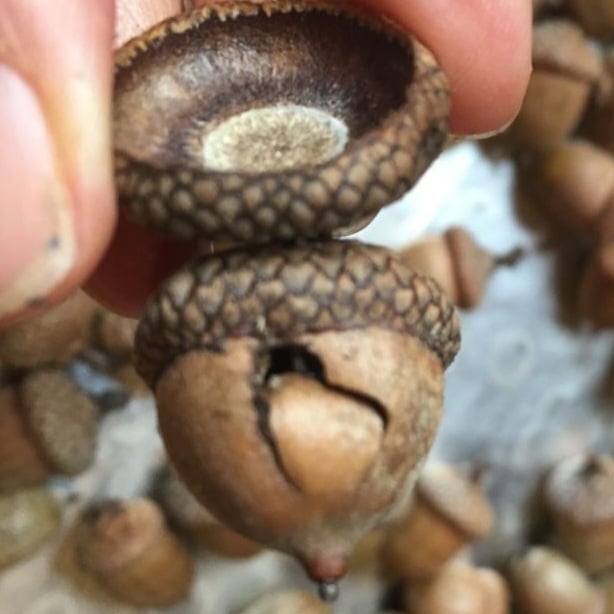I love when people who have clearly not had bedbugs link the Mark Rober video as if its the gold standard for eliminating bedbugs. There’s good bits in there, but he doesn’t tell the whole story and makes it seem like they’re easy to get rid of, which is actual misinformation.
The methods discussed in that video only work if you catch them from day one or as preventative measures to not get them in the first place. Bedbug females can hold onto the materials they need to reproduce for weeks before they actually start laying eggs. Furthermore, bedbugs release a stress pheromone when their environment is upset that alerts other bedbugs in the area that they should run and hide. Once this happens, you are SOL as you just made your situation far, far, worse.
DE, steam, and heat are only viable as control methods, not elimination methods. Methods that kill on contact will only make the situation worse as you need to allow bedbugs to return to their hoarding to spread the exterminant around. That’s why professionals use residual sprays to deal with them, not on-contact killers.
DE can and should be used alongside a professionally applied treatment, but you should never use it with the expectation that it alone will completely eliminate them. Bedbug nymphs are very similar to cockroaches in that they can squeeze into surfaces slightly larger than the human hair. If you see any bedbug regardless of life cycle stage, especially during the day, odds are you already have an infestation and should treat it as such.
I highly recommend working with a pest control company that uses Apprehend. Its a state of the art fungal insecticide that leaves a residual that survives for a minimum of three months after being sprayed and kills bedbugs within 24-48 hours of making contact with it. You can buy it online, but most people aren’t going to go the lengths necessary to learn how to properly spray it or how to treat for bedbugs longterm, which is what you need to do.
Also, for those using DE: Rockwell makes an insecticide called Cimexa. Its 10x more effective than DE and can be used on baseboards, crevices, and other nook and crannies in your house or apartment. You can also mix it with water and it will leave a residual spray that is good for 30 days after treatment.
Bedbugs in each life cycle can live up to 18 months without a blood meal, but they require a full blood meal to molt to their next life cycle stage. When treating for them, you want to seal anything you suspect of being contaminated in an air-tight container and not disturb it for at least 18 months, otherwise you risk reintroducing them to your living situation and starting everything all over again. Anything you want to be able to use immediately, you can seal in an air-tight container with a Nuvan strip for a minimum of a day or heat treat it using a specialized heat treatment enclosure if the item in question is not heat sensitive.
If you suspect you have them, check your mattress (especially in seams or tufts) and box spring first and be on the lookout for obvious blood stains or black pepper like markings on your sheets. Those are obvious indicators of a possible bedbug infestation and are the first things an exterminator will look for other than moltings or live bugs.
In order of preference bedbugs prefer living in:
- wood
- fabrics
- metal/plastic
Wooden furniture in particular is extremely susceptible to them. Once they establish a foothold, its usually better to throw the furniture out then attempt to salvage it. Bedbugs can and will live in anything if it means not being exposed or otherwise easily detected. This includes electronics like TVs, computers, laptops, remote controls, amongst other common household items.
If you think you have them, most extermination companies will do a free consult if you call them or visit their website to setup an appointment.
Source: I lived in an infested apartment complex for three years before being able to move elsewhere. Obviously, I didn’t know this before moving in or I would have looked elsewhere.
P.S. Most governments do not recognize bedbugs as anything more than a nuisance because they do not spread disease. In the US at least, we nearly had them eradicated in the late 80s before the EPA made the decision to ban heavy chemicals to treat them without offering any viable alternative. Private companies do not receive subsidies to treat them and due to their pervasive nature, once an infestation happens in a neighborhood or shared living arrangement, they spread very easily and make for very valuable repeat business. The best thing most people can do is educate themselves on the signs and proper response scenarios when they are detected. You want to approach them rationally. The natural response is to trigger a fight or flight scenario where you either go crazy trying to treat them yourself or you throw out all your furniture. Both approaches are wrong, and both approaches cause far more damage than good.
Elaborate what DE is
Diatomaceous Earth. It’s a powder of microscopic fossils. It’s a good non-toxic pesticide because it doesn’t use poison but works like microscopic razor blades on bugs and mortally wounds them when they walk over it
I have a feeling it probably works like microscopic razor blades in your lungs too
It’s not great to breathe in, but neither are chemical pesticides. It doesn’t really get kicked up in the air once it’s applied unless it’s actively disturbed.
If you’re going to use pesticides, they all come with tradeoffs and different situations you can use them.
Fair points
I had probably pretty bad bed bugs, felt pretty easy. But I did probably go overboard to ensure they were gone. Bed bugs spray killer directly, bombed twice. Washed known contaminated clothes very strongly. Ran all other clothes through just drier. full wall wipe, everything was washed and kept separated from room. Bombed again. Left outward facing tape along walls to see if they come back. Never had them again
I’m really happy this approach worked for you. It is possible to get rid of them yourself if you come up with a plan and stick with it.
I am, however, surprised to hear that bombing your house worked. Commercial fogging products, despite their claims, are not strong enough to kill them and will just drive them into hiding or into nearby units if you’re in an apartment building. Every pest management professional I’ve worked with has always told me to never fog for bedbugs.
I will say to anyone that reads this in the future, just because the immediate situation cools down and you don’t see them anymore, doesn’t mean you are free from them just yet.
Bedbugs take 10-20 days depending on environmental conditions to hatch. Their eggs are always laid in out of the way places you usually wouldn’t look and are cemented in place so even vacuums won’t pick them up. They’re smaller than a grain of rice and usually require magnification to see. Fogging products are ineffective against these, so even if they work against the bugs you can’t see, they won’t damage the eggs.You have to wait then out until they hatch. Residuals get around this by sticking to the surface of the egg and surrounding surfaces from adult bed bugs spreading it around. When nymphs hatch, they walk on the surface containing the residual and pick it up themselves.
If you do self-treat, you’ll need to repeat your treatment at least 2-3 times with a regular cadence to be certain that they are gone. Commercial bedbug extermination supplies usually come with instructions telling you how long you have to wait before reapplying it as well as how many times you should.
Some more facts about bedbugs that people might not know: Your average bedbug moves at about the speed of an ant or thereabouts. If recently fed, they move significantly slower, hence why they generally feed in the night, or during any other period where you are having an extended rest. Just like every other parasitic insect, they inject you with a combination anti-coagulant and numbing agent so you stay bleeding for a while and don’t feel a thing while they’re doing it.
Your bodies reaction to it varies from person to person, but you generally become desensitized to it over time. I’ve seen cases where the person doesn’t have any reaction to the bites at all, either during the time they are bitten or afterwards. That’s the worst type of reaction to have since most people only detect them when they’re actually bitten or after their body reacts to it and forms a welt or scab.
Also, bedbugs do not bite with a puncturing device like a mosquito. They scoop like a bulldozer would. If you look really closely with a magnification device, you should be able to tell that rather than a pin style hole at the site, you’ll see what appears to be more of a recess or well in your skin. Its not a guaranteed method by any means, but it can help differentiate their bites from those of other insects.
Due to the destruction they cause to your skin, you should never pick scabs that form on them. They will stay bleeding for whole minutes at a time and only a styptic pen can reliably stop it. They cause prolonged damage to your skin. I have what is essentially a scar on my left ankle from one where for over a year it looked like the surrounding skin had just died. It only recently started to heal back to a normal appearance/lighten.
Note that you should never rely on bites alone for identification as there are a whole array of common household insects that bite humans.
Thanks for all the information, your comments have been very insightful!
Now I actually want to subscribe to bedbug facts.
Residuals are the real key here. The same with getting rid of roaches. Newer generations of neonic insecticides (very safe indoors, no risk to bees) are slow acting, non-repelling and are extremely effective at knocking down populations pretty quickly. The critters will pick it up and spread it to wherever they are hiding. Combine this with steam cleaning, and it should severely knock down moderate infestations within a week and eliminate them in a few weeks.
I honestly wouldn’t even bother with DE. It’s messy and may not be great to breathe in, especially for pets. Its a decent physical barrier but there’s better ways to do that IMO.
So bedbugs can survive on nothing but air for well over a year literally anywhere in the structure of most houses. You can throw all your belongings in the trash and go live in a tent for a year and one of these fuckers will come out from under a drywall stud and start another infestation?
Why even throw out clothes and furniture then if you gotta douse the entire fucking house in black market DDT anyway?
Yes, they can. You should only be throwing things out if they are clearly infested or your pest management professional tells you to.
I am so thankful bedbugs is basically eradicated here, a shame about all the tourism slowly bringing it back though.
I had them back in 2012 in a townhouse we rented. Took almost two years of treatments. We would get treated and be fine for about 6-8 months and notice them again. It wasn’t until I begged the landlord to inspect the neighbouring units and that all were treated that we finally got rid of them. The fuckers can travel through walls and make lives incredibly difficult and irritating. Over a decade later and I still have PTSD about them.
+1 on cimexa, that was what finally got rid of bed bugs for me. Of course make sure your clothes and personal items are inspected and heat treat them. The best way I found to use cimexa is make sure your bed frame is metal and mattress is enclosed in bed bug proof cover.
Keep the bed away from walls and now since you’re the only food source, the bed bugs attempt to get to you by crawling up the bed posts. Make sure to have cimexa around your bed frame and posts. Guaranteed contact and highly effective on nymphs because it dehydrates the big body and kills them.
You know how in Plague Inc you can spread your disease via the Olympics?
I’m quite worried that will happen with bed bugs. We nearly eradicated them and have had decades of relative peace, but they’re having a hell of a resurgence. I genuinely fear a world where they become as widespread as they used to be.
Time to bring out the big gun (DDT) /s
deleted by creator
Yeah I unironically hold this stance. My original comment is usually followed by a brief rant about how we (as a species) almost did it but banned DDT a little too early. Might be a dumb take but I feel very strongly about bed bugs.
I suspect part of it is cynicism about climate change now, where things are so bad that it feels like using DDT for a few more years wouldn’t have hurt that much. I’m not versed enough about the effects on human health, but there is truly a level of increased health risk I would accept to exterminate bed bugs. They are a blight upon humanity and a return en massé would probably cause ecological/health damage of its own.
Plus high density housing is much more appealing if you can’t get a neighbor’s bed bugs or German roaches. That’s a massive and unavoidable downside to shared buildings. I am thankful to have avoided them so far but the likelihood only grows.
DDT wreaked absolute havoc on bird of prey populations. A LOT of species were on the verge of extinction due to being at the top of the food pyramid, where the DDT levels of all their prey animals added up. Banning DDT when we did was one of the biggest wins ever in bird protection.
Hm yeah, that’s fair. I wonder if limiting it to indoors pests, specifically the big two invasive species, would have prevented that. To my (very limited) knowledge, bed bugs aren’t eaten by many things. Bats? German roaches eat them but we don’t want them either.
I’m not overly attached to DDT though, a public health program of Alpine spraying indoors would probably do the trick. I doubt anyone has the political capital to get it done, but the return of bed bugs will be disastrous
I’ve always wondered how is every hotel not infested with these. With so many people coming and going you would think the chances of them being spread would be so high.
Do hotels have processes or protective mattresses that stop bed bugs taking over?
Work at a hotel. We have them occasionally. When a room is found to have them the room is put off market for 24 hrs as are any adjacent rooms either beside or above/below. They’re chemically treated at the beginning of the 24 hrs. This includes destroying ALL linens and chemically treating any fabric surfaces as well. The rooms are “flipped” with every headboard and painting removed from the walls during treatment. The mattresses have bedbug prevention (bedbug covers) already on them but they’re inspected and replaced regularly. At 16 hours the rooms are checked and verified there are no active bedbugs. The rooms are then steam treated for good measure. At 22 hours they’re cleaned with special vacuums to prevent relocation.
If a guest is in the room when they are found then all of their clothing and laundry are heat treated and inspected.
This seems to be the industry standard for large corporate hotels. I work for one of the largest in the world. This is our SOP. It’s expensive but we don’t end up with infestations so it apparently works.
That’s some good (and reassuring) information! I would see why you need to be on top of it, it would destroy a brand if it became known as bedbug infested.
Also a good reason to avoid AirBNBs
How are not all AirBNBd infested? is almost a more interesting question.
They are infested, but with stupid people instead.
That’s way more thorough than I would have expected!
I’m guessing it depends on the hotel management.
This is why we avoid Airbnb’s now plus the price is pretty much the same. Much better peace of mind.
Can you say what hotel.group this is? I want to go there.
I work for Travel and Leisure technically but specifically the Wyndham Resorts would be the line of hotels I work in. Even when I worked for Starwood Luxury Brand hotels it was similar but rather than chemical treatment it was whole room heat treatment which required removing nearly everything from the rooms first.
Thank you for your reply!
After this my main worry is public transport, which has many more people using it every day, and has so many surfaces for them to take over.
I’m itchy just thinking about it…
*starts looking up bedbug repellent
Possibly trains, buses also get treatment on a schedule 🤷♀️
You’d hope so! But of course I went searching and found only ominous articles telling me all the places I could potentially pick up bed bugs, and zero personal repellents.
I already hardly ever go out, this is definitely not helping 😂
Look into movie theatres. That’s a big culprit as well.
deleted by creator
Unless there are vegan ones, no.
Titles nowadays are useless.
There’s a crowd sourced plugin to rename YouTube videos.
Bedbugs hate this one weird trick
Bedbugs hate this one weird tick
Are Bedbugs Going to Take Over Humanity?
Holy crap… please warn us.
I got zapped by the third one not only shocked.
It’s just a pleonasm
What is it called?
Dearrow. I believe same developer of Sponsorblock.
You can replace thumbnails as well. It’s life changing.
https://chrome.google.com/webstore/detail/dearrow-better-titles-and/enamippconapkdmgfgjchkhakpfinmaj
thank you!
Bloodsucking ravenous bedbugs as opposed to peace loving endearing gnats.
“You know what they call bedbugs in France? ‘Le Royal with Bugs’.”
For those curious, they’re called “punaise de lit”, which literally translate to “bed stinkbug”, because technically they are the same family as stinkbugs.
Fun fact, stinkbug is also the word used for thumbtacks. Couldn’t find a reliable source on why though.
So obviously the right graphic to illustrate this is vial of bedbugs mixed with cream next to a one euro coin.
I was staring at that too, I think it must be a sticky bedbug trap in some containing tube
Read the article to find out.
I don’t know how large a one euro coin is, but even assuming it’s as tiny as the tiniest coins we have here (15mm in diameter), those bedbugs are still terrifyingly huge! Now, having looked up how large a 1€ coin is (23.25mm), and estimating from the image, those bedbugs are around 5mm long!
… I thought they’re huge, but having looked things up, it’s right about average. I thought they’re usually much smaller than that over here though (roughly 1mm in length). I probably have had the good luck of never having seen a bedbug in my life. Cockroaches though, are a normal part of life around here, hehe.
From my experience, years ago, they are nowhere near as big (closer to 1/5 of a normal finger nail), and they feel like your own personal biblical plague. So no recommendation from me.
I’ve just imagined a colony of them just chilling underneath my mattress and noped out of it.
You can’t even “deprive them of food” like one would address cockroaches and rats (like secure and seal the hell out of any food, make sure that food crumbs are properly disposed of, etc) because we are their food. Is there even a benefit to having them around, because if there isn’t, we probably should just eradicate them.
Mexico City is infested too.
Bedbugs have been seen in the subway, and this week, the chemistry faculty of UNAM suspended activities to look for bedbugs in the facility.
New fear unlocked.
I’ve been missing the apocalympics content
This would make a good sub name.
Mark Rober has a great video on bedbugs: https://m.youtube.com/watch?v=2JAOTJxYqh8
He finds that Diatomaceous Earth, steam, and heat are the way to go
So what you’re saying is “use Earth, Wind & Fire to get rid of bedbugs”?
Only in September
If you remember
Here is an alternative Piped link(s):
https://m.youtube.com/watch?v=2JAOTJxYqh8
Piped is a privacy-respecting open-source alternative frontend to YouTube.
I’m open-source; check me out at GitHub.
I’m very impressed to learn that dogs can be trained even to smell bed bugs.
Human can smell them too. They have a sickeningly sweet smell, like rancid raspberries.
As a New Yorker, whenever I visit Paris or other cities with metros that have upholstered seats, I always have a sense of disgust and fear I’m going to get bed bugs sitting on a seat. I don’t understand why they don’t have plastic seats like we do in the MTA for sanitary reasons.
When I visited Japan every seat on transit was fabric. Coming from SEPTA in Philly it truly skeeved me out
Try sitting on a plastic seat for six hours, it’s no fun.
On a metro commute you aren’t sitting for more than 90 minutes if all goes well. And paris is pretty small compared to NYC or London.
Comfort, I assume
I wonder if we could make more comfortable seats that aren’t easy warm homes for bugs
https://www.ncbi.nlm.nih.gov/pmc/articles/PMC3255965/
diatomaceous earth, steam, and heat are not the way to go and not practical
best you can do is pest control not pest elimination
hotel comment below is the procedure even in residential settings thanks Heratiki for an on the ground real world comment and below is the link to a list as to what stuff they use
https://www.epa.gov/bedbugs/pesticides-control-bed-bugs
https://www.amazon.com/gp/product/B01GKMHIM4/ref=ppx_yo_dt_b_search_asin_title?ie=UTF8&th=1
Can confirm - Alpine WSG is like a miracle for both bed bugs and roaches. It is both incredibly lethal, and slow acting, so bugs spread it to the places they are hiding, as well as the paths they take for food/water. Over time it will take out even very stubborn, hard to reach reservoirs because of the horizontal transfer properties.
Tbh, I find it a bit hard to take people suggesting DE seriously. It’s just not effective compared to modern treatment approaches, doesn’t really have any unique benefits, and is arguably way worse for you.
These suckers can go home with you via your clothes or suit case, then they multiply in your home
The Seven Plagues of Egypt…


















